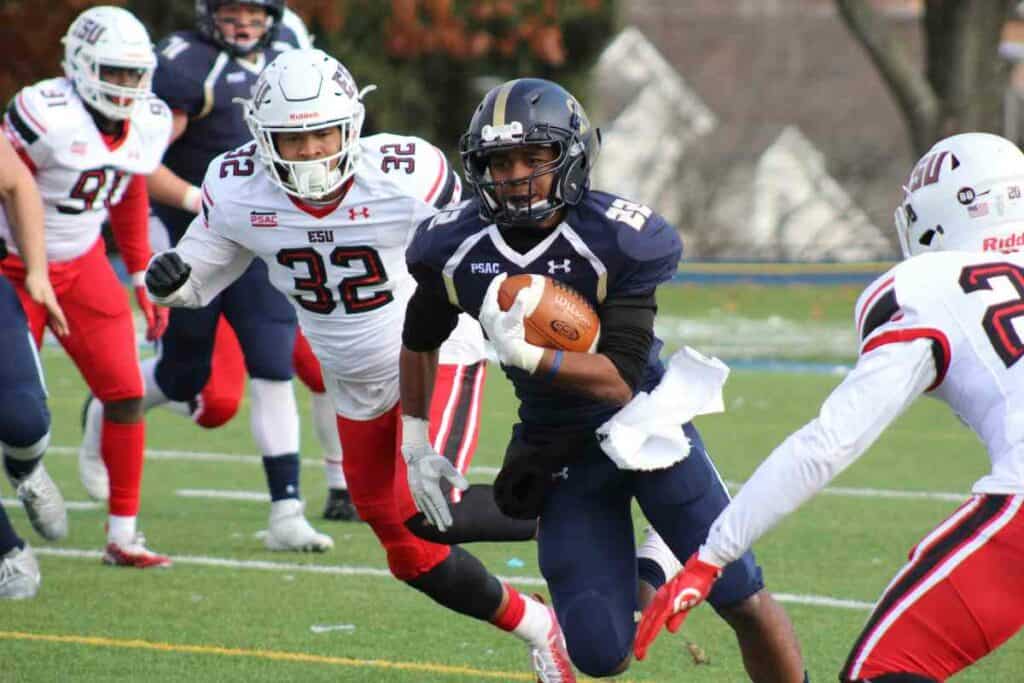Why College Football Games Are So Long: Understanding the Factors Behind the Lengthy Matches

College football games have been getting longer and longer over the years. According to NCAA statistics, the average game now takes 3 hours and 22 minutes, which is an increase of four minutes from just five years ago.
This trend has been a cause for concern among fans and analysts alike, as the length of games significantly impacts the overall experience of watching college football.
Why are college football Games So Long?
One of the primary reasons for the lengthening of college football games is the increase in the number of replays. The NCAA has implemented a replay system that allows officials to review certain plays to ensure that the correct call is made.
While this system has been effective in reducing the number of mistakes made on the field, it has also led to longer games. In some cases, a single replay review can take several minutes, which adds up over the course of a game.
Another factor that contributes to the length of college football games is the clock management strategy employed by teams. In college football, the clock stops after every first down, which means that teams can effectively extend the length of a game by repeatedly getting first downs.
This strategy is often used by teams that are trying to protect a lead or catch up in a game. While it can be an effective way to win a game, it also leads to longer games and can make the viewing experience less enjoyable for fans.
Factors Contributing to Game Length
College football games have become increasingly longer over the years, causing frustration for both fans and players. Several factors contribute to the length of these games, including clock rules, replay reviews, commercial breaks, TV timeouts, and halftime.
Clock Rules
Clock rules play a significant role in the length of college football games. The clock stops after every first down and incomplete pass, which can add up to several minutes of stoppage time.
Additionally, the clock stops during the last two minutes of each half, which can lead to lengthy game endings.
Replay Reviews
Replay reviews are another factor contributing to college football game length.
While replay reviews are essential to ensure accurate calls, they can also add several minutes to each game.
Reviews can sometimes be inconclusive, leading to further delays and frustration.

Commercial Breaks
Commercial breaks are a necessary evil when it comes to college football games.
Television networks rely on advertising revenue to support their programming, and commercial breaks are a significant source of income.
However, commercial breaks can add several minutes to each game, leading to longer game times.
TV Timeouts
TV timeouts are another factor contributing to college football game length. Television networks often take advantage of timeouts to run additional commercials, leading to longer game times.
Halftime
Halftime is an essential part of college football games, but it can also add to the length of the game. Halftime typically adds an additional 20 minutes to the overall game time.
While some of these factors are necessary, others could be reduced or eliminated to shorten game times.
The NCAA and conference commissioners should consider strategies to reduce game length while still providing a competitive game and an enjoyable experience for fans.
Clock Rules
The clock is constantly stopping and starting, which can lead to a lot of downtime during games. In 2023, the NCAA approved several rule changes aimed at speeding up college football games, including changes to clock rules.
One of the most significant changes is that the clock will now run after first downs in all divisions except Division III.
This change is expected to reduce the number of stoppages during games and speed up the pace of play. In the past, the clock would stop after every first down, which added a lot of time to games.
Another change is that the game clock will now start on kickoffs at the end of halftime and after scores. This change is expected to reduce the amount of time between plays and speed up the pace of play.
In addition to these changes, the NCAA also approved a rule that allows officials to reset the play clock to 20 seconds when there is a television timeout. This change is aimed at reducing the amount of time between plays and speeding up the pace of play.
Here is a table summarizing the clock rule changes for the 2023 season:
| Rule Change | Impact |
|---|---|
| Clock runs after first downs | Speeds up pace of play |
| Game clock starts on kickoffs | Reduces time between plays |
| Play clock reset to 20 seconds during TV timeouts | Reduces time between plays |
The 2023 rule changes are expected to reduce the number of stoppages and speed up the pace of play, but it remains to be seen how much of an impact they will have on game length.
Replay Reviews
Replay reviews have become an integral part of college football games and have contributed to the increased length of games.
The time taken for replay reviews has been a major concern for fans and players. Here, we will discuss how replay reviews for incompletions and touchdowns have affected the length of college football games.
Incompletions

When a pass is ruled incomplete, the referees can review the play to determine if the pass was complete or incomplete.
This process can take several minutes, and it can be frustrating for fans who are waiting for the game to resume. Games often average 2 replays per game at the FBS level.
Touchdowns
When a touchdown is scored, the referees can review the play to determine if the player crossed the goal line before being tackled.
This process can take several minutes, and it can be frustrating for fans who are waiting for the game to resume. According to a report by The Athletic, the long replay reviews have been contributing to the increased length of college football games.
To understand the impact of replay reviews on the length of college football games, let’s take a look at the table below:
| Year | Average length of game |
|---|---|
| 2017 | 3 hours, 7 minutes |
| 2018 | 3 hours, 16 minutes |
| 2019 | 3 hours, 23 minutes |
| 2020 | 3 hours, 24 minutes |
| 2021 | 3 hours, 27 minutes |
| 2022 | 3 hours, 28 minutes |
As we can see from the table, the average length of college football games has been increasing over the years.
While several factors contribute to the increased length of games, replay reviews have been a significant contributor to the problem.
While replay reviews are essential to ensure that the game is played fairly, steps must be taken to reduce the time taken for these reviews.
Commercial Breaks
On average, there are around 16 commercial breaks during a college football game, and they can last between 2.5 to 3 minutes each.
The networks cut away to commercial breaks after changes of possession, scores, the end of the quarter, timeouts, and reviews.
If one team scores, we go to a commercial, and if another team scores quickly, we’re right back to commercials.
These commercial breaks are necessary for the networks to make money, but they are ruining the viewing experience for fans.
Watching a game that takes four hours to complete is frustrating when the actual playing time is only around 60 minutes. The constant interruptions make it difficult for fans to stay engaged and invested in the game.
One possible solution to this problem is to reduce the number of commercial breaks during a game. While this may not be feasible for the networks, it would certainly make the viewing experience more enjoyable for fans.
Another solution is to shorten the length of the commercial breaks. By reducing the length of each break, networks could still make money while also making the game more enjoyable for fans.
While it may not be feasible for networks to reduce the number of commercial breaks, shortening the length of each break could go a long way in improving the viewing experience for fans.
TV Timeouts
These timeouts occur when the television broadcast takes a break for commercial purposes and can last for several minutes. College football games average about 20 minutes of TV timeouts per game.
It’s not just the number of TV timeouts that is the problem, but also their timing. TV timeouts often occur at the most inconvenient times, such as after a big play or right before a crucial play. This can disrupt the flow of the game and make it harder for teams to maintain momentum.
ESPN, one of the major college football broadcasters, is often criticized for the number and length of TV timeouts during their broadcasts.
However, it’s important to note that TV timeouts are not solely the fault of the broadcasters. The NCAA and the conferences also have a say in how many TV timeouts are allowed during a game.
While broadcasters like ESPN may be criticized for the number and length of TV timeouts during their broadcasts, it’s important to remember that the NCAA and the conferences also have a role to play in regulating the number of TV timeouts allowed during a game.
Halftime
Halftime is a crucial part of any football game, and college football is no exception. According to the NCAA rule book, halftime in college football should be 20 minutes long.
However, it can be shortened before the game “by mutual agreement of the administrations of both schools or if the game is delayed by weather, lights, or other unforeseeable circumstances.”
During halftime, players have a chance to rest, hydrate, and refuel. Coaches can make adjustments to their game plan, and players can receive medical attention if necessary.
Additionally, halftime is an opportunity for the marching band and cheerleaders to perform, adding to the overall game-day experience.
In contrast, the halftime break in the NFL is only 12 minutes long. With marching bands being such an ingrained part of the college football culture, it’s hard to see that changing anytime soon. This is part of why the average length of an NFL game is typically shorter than an NCAA game.
It’s worth noting that the length of halftime can vary depending on the game.
For example, during the College Football Playoff National Championship game, halftime is extended to 30 minutes to accommodate the halftime show and other festivities.
In conclusion, halftime is a crucial part of any college football game, providing players with a chance to rest and coaches with an opportunity to make adjustments.
While the extended halftime break may contribute to the overall length of college football games, it’s a tradition that fans have come to expect and enjoy.
